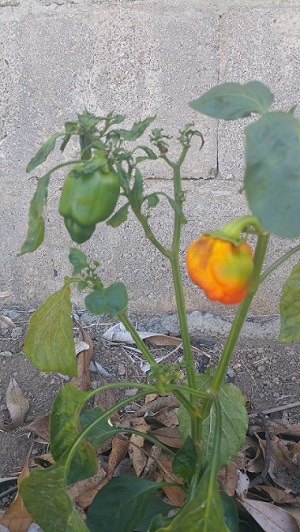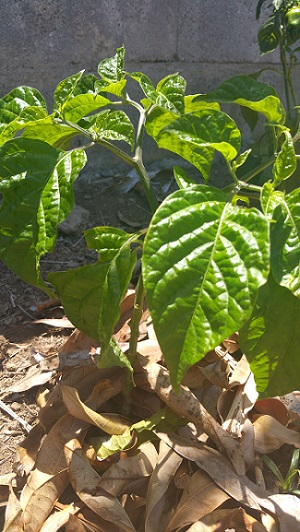Hi folks, it’s Abi here and I am back with another blog about my gardening experience and today I’d like to focus on my lovely peppers. To avoid repetition, I won’t go into the details of how I grew my peppers as I used the exact same technique I used when growing my tomatoes which you can read here. What I thought I would do is focus on what I learnt from growing peppers, some of the challenges I encountered and how I overcame these.
Over the past 8 months or so I have been trying to grow four types of peppers – sweet peppers (or bell peppers), Scotch bonnets, Jalapeno peppers and Caribbean seasoning peppers (very similar to Scotch bonnets, but without the heat). Growing these peppers has been a huge challenge and I suppose I was lulled into a false sense of security as I started my gardening journey with tomatoes and okras which have been a breeze in comparison to peppers. If I had to score myself on my pepper assignment I would have to give myself a big fat D, I have failed miserably. I have only had some success (after several attempts) with sweet peppers and it looks like my third attempt at Scotch bonnets may (I don’t want to speak too soon) have produced some results. Here are some of the challenges that I encountered that led me to give myself a big fat D.
Germination Was a Struggle
Whilst reading up on how to grow peppers, I did learn that germination of peppers does take a lot longer than tomatoes, up to a month. So, I was prepared for that. On my first attempt I planted 24 bell pepper seeds and 24 Scotch bonnet seeds in my seed starting tray (egg containers!), and patiently waited. I watered my soil regularly and with no sign of seedlings at 3 weeks, I wasn’t worried, I thought: ‘well, I have read that it can take up to a month so no problem.’ I waited. After a month, nothing happened, but I was still optimistic and continued to wait patiently. At 6 weeks, I started to get worried and then after two months, I gave up and started again. This time I added Jalapeno and Caribbean seasoning peppers to my pepper collection and sadly I got the same results (I gave up after 6 weeks). I was disappointed. I couldn’t figure out what was going wrong, so after 4 months and 2 attempts I took a trip down to the St Kitts Agricultural Department to get some advice. They were lovely, really helpful and friendly. They explained it could be the seeds and that peppers can be a bit “particular” and I should keep trying. They did say maybe I should cheat and buy some of their young pepper plants which were growing well in their nursery and so I did, I cheated. I bought a row of pepper plants and transplanted them into the garden, thinking perfect I have a head start, but I had challenges with their growth too – I don’t think peppers like me.
I still wanted to try to grow peppers from seed so I tried again and again with the seeds and finally I was able to get my bell peppers and some hot peppers to germinate (yay!). These are going well, but slowly.
Peppers Are Slow
Having cheated and bought some seedlings and then finally had some success with my own seeds, I have quite a few pepper plants growing in my garden. Starting my gardening journey with tomatoes spoilt me because they grew relatively fast and I was expecting the same for my peppers, but pepper plants, or I should say my pepper plants, were sloooow! They really are taking their own time (but it may be my growing technique as I am a newbie!). If you’re going to grow peppers, you’ll need some patience. As I sit here now I do have some really cute bell peppers developing and I have harvested about two (Very tasty!), but the Scotch bonnet is growing extremely slowly. So, with all the attempts and buying of seedlings it has taken me about 5 months to get my first bell pepper.
They Need Lots of Water
I live in the Caribbean and it has been really hot over the past few months and some of the challenges with the slow growth could be because they weren’t getting enough water (I am not sure). I may have underestimated the amount of water that they needed. I am always worried about watering too much and my plants dying of root rot, so I suppose I am a little conservative when it comes to watering. A couple of months ago, we had a guest over and they were looking at my garden and she felt I needed to give my plants a lot more water. So, she took over for a few days and soaked my peppers. I was really worried thinking they might drown. After about a week, my peppers seemed to perk up and looked a lot happier. Since then I can’t say they have grown any faster but they certainly look a lot healthier.
My Peppers Were Bugged!
Just as I was having some success with my bell peppers and feeling really good about them, I ventured out into the garden one morning and found that my largest pepper plant had lost ALL its leaves. I was shocked. How did that happen in just one night or morning? I looked around and spotted the culprit. A sneaky little green worm, which I later learned was a hornworm, ate my pepper leaves for breakfast. It was so greedy! It didn’t leave anything, all the leaves were gone. I was so upset and I thought that was it for that pepper plant. To my surprise and joy, about a week later my pepper plant started making a come-back, some new leaves were growing happily. I’ll see how it goes, I have my fingers crossed that this plant will survive.
Now, everyday I check my garden for hornworms and I have spotted a few which I have swiftly thrown over the wall!
It Has Been Fun
Although I haven’t been so lucky with my peppers it has been a lot of fun and a nice challenge. It has also been very rewarding too. When I noticed my first pepper, I was elated and when I picked my first pepper I was so proud of myself for persisting, it really was worth it. Although the bell pepper was a lot smaller than I expected, it tasted lovely.
A Great Learning Experience
I have learnt a lot about peppers over the past few months. Through my reading I have learnt that there are thousands of types of peppers (Wikipedia says about 50,000!!), which came as a real shock to me, I was only aware of five different types of peppers before I started looking into them. This means there is a type of pepper for every taste bud (sweet, hot, fruity, woody and smoky) and peppers come in a variety of shapes, sizes and colours (red, green, orange, yellow, purple and more).
When we look at the history of peppers, they are native to Mexico, Central America and South America. They made their way to Spain in 1493 and from there spread to other countries.
Peppers are also quite nutrient rich, their nutrient content is dependent on the type of pepper, but most peppers contain vitamin A, C, K, B6, dietary fibre, thiamine, niacin, folate, magnesium, copper, potassium and manganese.
I have also learnt some personal lessons about the importance of patience, persistence and hard work (they really gave me a good workout).
I’m really looking forward to picking more bell peppers and watching my Scotch bonnets develop. I’ll keep you posted.
If you missed my previous blogs you can read them using the links below:














